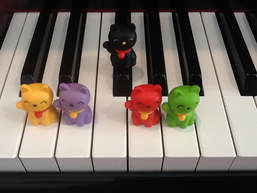
So, what is my position on “positions”? I think that positional reading, used correctly, can be a good thing! Today I will be sharing my thoughts on positional reading--the good, the bad, and how it can help your students.
The Benefits of Positional Reading
Our fingering system for piano playing is based on the idea of economy of motion—playing groups of notes without moving the hand in order to create smooth phrases. A benefit of positional reading is that it encourages students to use all five fingers equally, developing finger strength and navigating melodic phrases without moving unnecessarily. This is an important skill for students to learn, as many students tend to favor their strongest fingers (typically 1, 2, and 3) when given the option.
Positional reading also teaches students to look for scale patterns. In fact, instead of using the term “position,” I prefer to talk with students about what scale a particular passage uses. For example, if a particular passage uses only the notes C, D, E, and G, it probably makes sense to prepare the hand for a C scale so that the notes can be played without moving. I think that helping students to look for these patterns is a good thing! It encourages students to read in “chunks” as opposed to note-by-note, and it prepares them for the day when they will need to determine the most logical fingering for their pieces on their own.
Finally, the limited number of notes present in “positional” pieces, and the comfort of staying in one place on the piano, can be very helpful for students as they are learning to read notes on the staff. I find that starting students with just a few notes on the staff, then adding more only as they are comfortable, is a logical way to help students become secure note readers.
The Drawbacks of Positional Reading
Problems arise with positional reading, however, when students begin to associate a particular finger with a key on the piano (for example, thinking that their thumb is always on C). Students can also use positional reading as a crutch, asking their teacher what position a piece is in instead of using the fingering to determine their starting place. However, I have found that there are several ways to eliminate these issues! Here are my tips:
- Encourage moving around the keyboard using rote pieces and creative activities. Once students experiment with playing pieces all around the keyboard, they quickly learn that their thumb won’t always be on C! Because these activities don’t require note reading, they make it easier for students to play in a variety of starting places with confidence. Look HERE for my favorite beginning improv activities using the black keys.
- Encourage students to watch fingering carefully, even for “positional” pieces. I get students in the habit of naming the first note and first finger number used in a piece right away. Students quickly learn that the questions “what position is this in?” or “where do my hands go?” are met with the response “you tell me!” I also created a card game found HERE to help my students practice the concept of matching a note and finger number on the piano.
- Transpose. I have blogged about the benefits of transposition HERE. I encourage my students to transpose their pieces as soon as possible. Even a simple three-note piece using only C-D-E can also be played on F-G-A, or G-A-B, or even Gb-Ab-Bb! Students are usually intrigued to find that they can play the same piece in many different places on the piano. I also created transposing challenge worksheets to use with my students that you can find on my "Free Stuff" page HERE.
- Supplement. If a student is using a method book with a positional approach, I like to supplement with sheet music or a book from a different method series that uses a different fingering pattern. This way, students get security from playing the “positional” piece, but are stretched a bit by playing a piece that starts in a different place on the piano.
So, you have read my thoughts on positional reading—I would love to hear yours! Do you teach “in positions?” Why or why not? Please share your thoughts in the comments!

 RSS Feed
RSS Feed